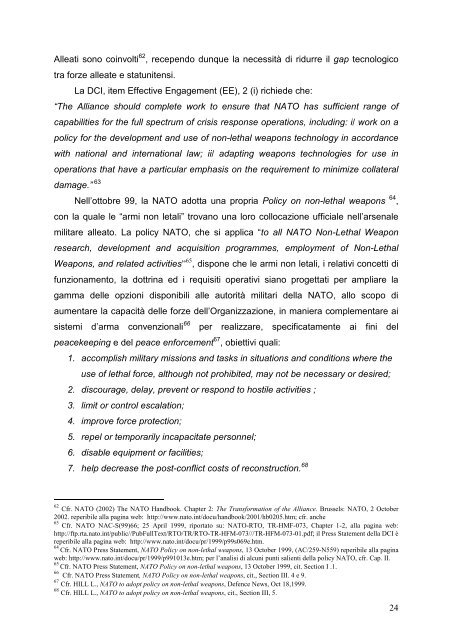Le armi cosiddette non letali - Assemblea dell'Officina di Fisica
Le armi cosiddette non letali - Assemblea dell'Officina di Fisica
Le armi cosiddette non letali - Assemblea dell'Officina di Fisica
Create successful ePaper yourself
Turn your PDF publications into a flip-book with our unique Google optimized e-Paper software.
Alleati sono coinvolti 62 , recependo dunque la necessità <strong>di</strong> ridurre il gap tecnologico<br />
tra forze alleate e statunitensi.<br />
La DCI, item Effective Engagement (EE), 2 (i) richiede che:<br />
“The Alliance should complete work to ensure that NATO has sufficient range of<br />
capabilities for the full spectrum of crisis response operations, inclu<strong>di</strong>ng: i/ work on a<br />
policy for the development and use of <strong>non</strong>-lethal weapons technology in accordance<br />
with national and international law; ii/ adapting weapons technologies for use in<br />
operations that have a particular emphasis on the requirement to minimize collateral<br />
damage.” 63<br />
Nell’ottobre 99, la NATO adotta una propria Policy on <strong>non</strong>-lethal weapons 64 ,<br />
con la quale le “<strong>armi</strong> <strong>non</strong> <strong>letali</strong>” trovano una loro collocazione ufficiale nell’arsenale<br />
militare alleato. La policy NATO, che si applica “to all NATO Non-<strong>Le</strong>thal Weapon<br />
research, development and acquisition programmes, employment of Non-<strong>Le</strong>thal<br />
Weapons, and related activities” 65 , <strong>di</strong>spone che le <strong>armi</strong> <strong>non</strong> <strong>letali</strong>, i relativi concetti <strong>di</strong><br />
funzionamento, la dottrina ed i requisiti operativi siano progettati per ampliare la<br />
gamma delle opzioni <strong>di</strong>sponibili alle autorità militari della NATO, allo scopo <strong>di</strong><br />
aumentare la capacità delle forze dell’Organizzazione, in maniera complementare ai<br />
sistemi d’arma convenzionali 66 per realizzare, specificatamente ai fini del<br />
peacekeeping e del peace enforcement 67 , obiettivi quali:<br />
1. accomplish military missions and tasks in situations and con<strong>di</strong>tions where the<br />
use of lethal force, although not prohibited, may not be necessary or desired;<br />
2. <strong>di</strong>scourage, delay, prevent or respond to hostile activities ;<br />
3. limit or control escalation;<br />
4. improve force protection;<br />
5. repel or temporarily incapacitate personnel;<br />
6. <strong>di</strong>sable equipment or facilities;<br />
7. help decrease the post-conflict costs of reconstruction. 68<br />
62 Cfr. NATO (2002) The NATO Handbook. Chapter 2: The Transformation of the Alliance. Brussels: NATO, 2 October<br />
2002. reperibile alla pagina web: http://www.nato.int/docu/handbook/2001/hb0205.htm; cfr. anche<br />
63 Cfr. NATO NAC-S(99)66; 25 April 1999, riportato su: NATO-RTO, TR-HMF-073, Chapter 1-2, alla pagina web:<br />
http://ftp.rta.nato.int/public//PubFullText/RTO/TR/RTO-TR-HFM-073///TR-HFM-073-01.pdf; il Press Statement della DCI è<br />
reperibile alla pagina web: http://www.nato.int/docu/pr/1999/p99s069e.htm.<br />
64 Cfr. NATO Press Statement, NATO Policy on <strong>non</strong>-lethal weapons, 13 October 1999, (AC/259-N559) reperibile alla pagina<br />
web: http://www.nato.int/docu/pr/1999/p991013e.htm; per l’analisi <strong>di</strong> alcuni punti salienti della policy NATO, cfr. Cap. II.<br />
65 Cfr. NATO Press Statement, NATO Policy on <strong>non</strong>-lethal weapons, 13 October 1999, cit. Section I .1.<br />
66 Cfr. NATO Press Statement, NATO Policy on <strong>non</strong>-lethal weapons, cit., Section III. 4 e 9.<br />
67 Cfr. HILL L., NATO to adopt policy on <strong>non</strong>-lethal weapons, Defence News, Oct 18,1999.<br />
68 Cfr. HILL L., NATO to adopt policy on <strong>non</strong>-lethal weapons, cit., Section III, 5.<br />
24


